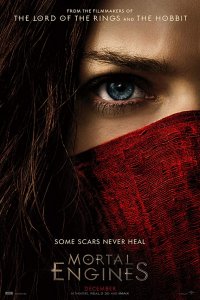London Rolling, or, The Empire Slides Back: Gary Westfahl Reviews Mortal Engines
 I must first admit that I enjoyed Christian Rivers’s Mortal Engines far more than I thought I would, and the film’s first hour definitely qualifies as a marvelous piece of entertainment. Unfortunately, this story about motorized, traveling cities starts to sputter and run out of gas as it progresses, at the precise time when the filmmakers evidently believed that they were ratcheting up the excitement to an even greater level. The problem, I believe, is that Rivers and screenwriters Fran Walsh, Philippa Boyens, and Peter Jackson apparently grew uneasy about the risk of showing audiences things they have never seen before, and instead decided to fall back on surefire crowd-pleasing gimmicks that they have seen many times before.
I must first admit that I enjoyed Christian Rivers’s Mortal Engines far more than I thought I would, and the film’s first hour definitely qualifies as a marvelous piece of entertainment. Unfortunately, this story about motorized, traveling cities starts to sputter and run out of gas as it progresses, at the precise time when the filmmakers evidently believed that they were ratcheting up the excitement to an even greater level. The problem, I believe, is that Rivers and screenwriters Fran Walsh, Philippa Boyens, and Peter Jackson apparently grew uneasy about the risk of showing audiences things they have never seen before, and instead decided to fall back on surefire crowd-pleasing gimmicks that they have seen many times before.
Officially, Philip Reeve’s Mortal Engines (2001) is a work of science fiction, set on a post-apocalyptic Earth where devastated cities have transformed themselves into monstrous predatory vehicles that roam the countryside and devour other cities. This is hardly a new idea: the concept of mobile residences on a smaller scale can be traced back to stories like Jules Verne’s The Steam House (1880) and “Hicks’ Inventions with a Kick: The Perambulating Home” (1928) by Henry Hugh Simmons (Clement Fezandié); Christopher Priest’s The Inverted World (1974) offered a memorable picture of a city slowly traveling across its bizarre world by laying down tracks; and Greg Bear’s Strength of Stones (1988) envisions moving cities with minds of their own that expel their residents.
However, if one considers the huge expense and difficulty of constructing and maintaining a single car, and imagines a car that is a million times larger, it becomes obvious that any resources one might obtain by building an ambulatory city would be dwarfed by the resources needed to keep it running. It is also illogical for Reeve to assume that people living thousands of years in the future would inexplicably revert to the styles and social structure of Victorian England, and that residents of a post-apocalyptic society would reacquire the technology of the Industrial Revolution while remaining ignorant of the more advanced machines of the twentieth century and beyond. (I don’t recall seeing anyone in the film reading books, where such information could presumably be found.) For that matter, if “Quantum Energy” was powerful enough to destroy civilization in one hour and rearrange Earth’s surface, how was so much of ancient London preserved intact?
Such objections could be multiplied, but they are also insignificant: readers primarily value visions of the future because they are interesting, not because they are plausible, and Reeve’s portrait of a nineteenth-century London slowly moving around on immense tracks represents a fascinating exercise in world-building, ideally suited to an era enamored of other “steampunk” stories about improbably advanced Victorian technology. Like other works in the subgenre, the novel might be best regarded, in accordance with Reeve’s original plan, as a fantasy of alternate history. What animates the first hour of Rivers’s film, then, is the energy and enthusiasm that the filmmakers devoted to developing and visualizing Reeve’s incongruous future world. The city of London advances while adorned with two enormous lions’ heads; amidst the clutter of other constructs, one can still observe the tower of Big Ben; a sign indicates that Tottenham Court Road remains in place; and St. Paul’s Cathedral is now the headquarters of the mysterious “Energy Project” of leader Thaddeus Valentine (Hugo Weaving). In another smaller city, tea is still brewed and served in porcelain cups, though it now made from algae. The hoariest device in cinematic history – the car chase – is given new life when it is restaged involving two cities, as London pursues a smaller city, finally opening up enormous metallic jaws to consume its victim; and the huge tracks left by the moving cities provide convenient pathways for travelers. (This is also one of the few films that is actually improved by 3D, as it makes its special effects even more impressive.)
The London Museum looks as stuffy and old-fashioned as ever, but its devotion to preserving artifacts from the past now reflects surprising priorities: young historian Tom Natsworthy (Robert Sheehan) is thrilled to discover an almost-intact toaster, and the museum proudly displays statues of those icons of twenty-first-century culture, the Minions. Even ancient food is valued: Tom’s inadvertent companion Hester Shaw (Hera Hilmar) takes out a package of Twinkies and eats one, and when Tom protests that it is thousands of years old, she replies, “The food of the ancients is indestructible” – a discovery also made by a cockroach in another film about a post-apocalyptic future, Wall▪E (2008 – review here: http://www.locusmag.com/2008/Westfahl_Wall-E.html ). (I have given up speculating about why this particular treat so often appears in science fiction films, but its popularity in the distant future seems ironic, since our own contemporary disdain for this less-than-healthy food drove the Hostess company into bankruptcy.)
However, many people in this world are most interested in finding and reactivating pieces of advanced technology from the past, no longer understood but potentially usable. Thaddeus particularly wants to employ the virtually limitless “Quantum Energy” that devastated the planet during the “Sixty-Minute War,” provided by a device called Medusa, so he can break down the wall protecting London’s enemies, the Anti-Traction League, and revive the city’s fortunes. And it is as this McGuffin begins to dominate the story line that Mortal Engines starts to become less involving.
There are several related issues that cause Mortal Engines to break down. While Anti-Traction agent Anna Fang (Jihae) does function as a heroic figure in the novel, the film needlessly transforms her into an invincible woman warrior, who in a particularly silly scene contrives to single-handedly defeat dozens of armed opponents. Here, rather than being innovative, the filmmakers are simply replicating similar sequences from dozens if not hundreds of previous films, failing to realize (like their predecessors) that such scenes are more laughable than exciting. Another familiar element comes with the introduction of the resurrected human called the Shrike (Stephen Lang), because the way he looks and acts is lamentably similar to the shtick of the zombies that are now ubiquitous in films, television programs, and video games; somehow, steampunk and a touch of the Zombie Apocalypse simply don’t blend together well.
Further, the novelty of the film’s concept involved the variety of its forms of land transportation: the enormous and menacing London; the smaller city London preys upon, its antiquated machinery gradually falling apart as it frantically flees and almost falls off a cliff; and an even smaller city that resembles a metallic centipede, covered with plates that enable it to lie low and blend in with the surrounding landscape. But the film increasingly takes to the sky, and it devotes insufficient attention to potentially intriguing objects like Anna Fang’s elegant red airship and the cluster of hydrogen balloons supporting the aerial city of Airhaven. Instead, one increasingly observes flying vehicles that uncomfortably resemble those of the Star Wars films, engaged in precisely the sorts of desperate attacks on larger opponents that have become one of the franchise’s clichés.
Indeed, as the film begins to significantly diverge from Reeve’s plot, it seems to repeatedly borrow from the original Star Wars (1977) and its sequels. A brief hint in the novel is elevated to the status of a major revelation that recalls a scene in The Empire Strikes Back (1980); an implacable villain in the novel suddenly repents to become a hero in the manner of Darth Vader in Return of the Jedi (1983); and the Medusa weapon in operation makes London resemble the Starkiller Base of Star Wars: The Force Awakens (2015 – review here). More broadly, while Hester Shaw is an important character in the novel, the film emulates the Star Wars franchise in promoting the concept of the Chosen One, the magical youth who is solely capable of saving the universe. Thus, it seems, virtually every character in Mortal Engines is obsessed with either killing Hester Shaw or rescuing Hester Shaw, and though it takes a while for her to realize it, she also happens to possess the precise McGuffin that is capable of shutting down Valentine’s demonic machine. Then, in the time-honored manner, other characters happily sacrifice their own lives so that Hester Shaw can fulfill her destined role as the preserver of civilization. One must acknowledge that Reeve’s story does have some creaky moments, so to speak, so that some revision and streamlining would not necessarily have been objectionable; but it is regrettable that screenwriters Walsh, Boyens, and Jackson chose to follow so many well-worn paths while doing so. (It is a phenomenon I have discussed elsewhere: producers are often attracted to source material because it seems so unusual and different; but in the process of adapting such stories, they are inexorably driven to make them resemble every other film that comes out of Hollywood.)
The film also omits certain aspects of Reeve’s novel, for reasons that seem clear enough. As a resident of Great Britain, Reeve is keenly aware of the distinct classes that long characterized British society, and his futuristic London reflects those divisions: the city is governed by professional guilds (of engineers, historians, and so on) recalling medieval times, and Reeve mentions that the city’s wealthiest people live at the highest levels, so they are not bothered by the loud, polluting machinery that the poor must endure. Realizing that non-British audiences are much less concerned with social classes, the filmmakers’ references to them are rare: the only one I recall is that Valentine’s daughter Katherine (Leila George) can flash a card and quickly escort the lowly Tom through a checkpoint. Also, the novel presents Valentine and the city’s Lord Mayor, Magnus Chrome (Patrick Malahide), as allies in seeking to activate Medusa and conquer their foes; but preferring to focus the audience’s ire on a single despicable figure, the filmmakers present Valentine as the sole instigator of the scheme, with Chrome recast as a benign leader who is duped and ultimately usurped by Valentine.
In contrast, the film places greater emphasis on the novel’s geopolitical conflict. London naturally represents western society, and the way it ravages other cities could be viewed as a representation of capitalism in its most exploitative and destructive form (with “city-eat-city” replacing “dog-eat-dog”). The opponents of London and other predator cities, termed the Anti-Traction League, are located to the east, in a region called Shun Gao, which is clearly China. (The “Sixty-Minute War” evidently shifted Earth’s crust – the “Big Tilt” – so as to bring Europe and China closer together.) And the “Shield Wall” that protects Shun Gao obviously recalls the Great Wall of China, also constructed to keep out western invaders. However, while Reeve otherwise does little to make his story a matter of the sinister West battling the benevolent East, the film is less hesitant: the leader of Shun Gao, Governor Kwan (Kee Chan), wears Chinese garb, and even as he prepares to order a military strike against the advancing London, he stresses his society’s high regard for preserving life at all costs. The Chinese Anna Fang is also given a larger role, and a higher status, than she has in the novel. All of this reflects one reality of contemporary filmmaking: the most important market for major films is no longer the United States, but rather the more populous nation of China. So, even if (as seems likely), American filmgoers do not flock to the theatres to see Mortal Engines, the filmmakers can still earn a handsome profit if Chinese audiences like their film.
The novel also states that the Shield Wall is adjacent to the city of Batmunkh Gompa, visited in the novel by Valentine, who pretends to be a monk. In the film, though, that setting is never observed, or even mentioned, and Valentine’s treacherous activities are omitted. Why? Well, it just so happens that a “gompa” is a building devoted to Tibetan Buddhism, as Reeve reasonably assumed that the westernmost region of Shun Gao might be a portion of Tibet. Yet as everyone knows, the Chinese are extraordinarily sensitive about the issue of Tibet, and even the faintest suggestion that, sometime in the distant future, a Tibetan city might enjoy a sort of autonomy could never have been countenanced in a film aimed at the Chinese market.
Finally, if a film is seeking to please foreign audiences all over the world, it never hurts to insert some criticism of the policies of Donald Trump. Hence, after London has “ingested” that smaller city and is escorting its residents inside, it is announced that “children may be temporarily separated from their parents” – manifestly referring to the much-criticized treatment of families of refugees entering the United States. As if to contradict the impression that Londoners are inhumane to outsiders, Valentine shortly thereafter announces to them that “you all deserve to be treated with dignity and respect”; but it has been evident from the onset that Valentine is a scoundrel, so his words cannot be trusted, and his hypocrisy is underlined by the fact that we observe a man being brutally disciplined when he attempts to bring a weapon into the city. In sum, London’s leaders may be eager to obtain artifacts and ancient technology from other cities, but they are not particularly interested in welcoming immigrants.
Mortal Engines is not the sort of film that can inspire any closing profundities. It is what it is, a film one cannot entirely dislike, a film one cannot entirely like, and a film that seems driven by no purpose other than to generate income for its creators. It is perhaps worth noting that Reeve’s title is taken from a speech in William Shakespeare’s Othello (c. 1604, 1622) when the Moor of Venice, distressed to hear that he has been betrayed by his wife, is prepared to abandon the warfare that once earned him renown. And certainly, one can say both Reeve’s novel, and this film adaptation, do display a certain lack of ambition.
Directed by Christian Rivers Written by Fran Walsh, Philippa Boyens, and Peter Jackson, based on the novel by Philip Reeve Starring Hera Hilmar, Robert Sheehan, Hugo Weaving, Jihae, Ronan Raftery, Leila George, Patrick Malahide, Stephen Lang, Colin Salmon, Mark Mitchinson, Regé-Jean Page, Menik Gooneratne, Frankie Adams, Leifur Sigurdarson, Kahn West, Andrew Lees, Sophie Cox, Sarah Peirse, and Kee Chan
Gary Westfahl has published 28 books about science fiction and fantasy, including Science Fiction Quotations: From the Inner Mind to the Outer Limits (2005), The Spacesuit Film: A History, 1918-1969 (2012), and A Sense-of-Wonderful Century: Explorations of Science Fiction and Fantasy Films (2012); excerpts from these and his other books are available at his World of Westfahl website (here). He has also published hundreds of articles, reviews, and contributions to reference books. His most recent books are the three-volume A Day in a Working Life: 300 Trades and Professions through History (2015), An Alien Abroad: Science Fiction Columns from Interzone (2016), the co-edited Bridges to Science Fiction and Fantasy: Outstanding Essays from the J. Lloyd Eaton Conferences (2018), and Arthur C. Clarke, part of the University of Illinois Press’s Modern Masters of Science Fiction series.
©Locus Magazine. Copyrighted material may not be republished without permission of LSFF.








“Such objections could be multiplied, but they are also insignificant: readers primarily value visions of the future because they are interesting, not because they are plausible…..”
Really? I was pulled into reading science fiction in 1953 when I found that the stories Heinlein was writing were interesting because they were plausible.